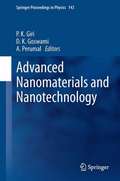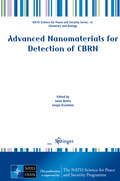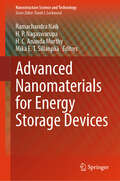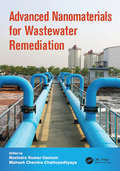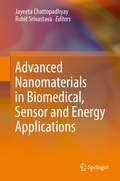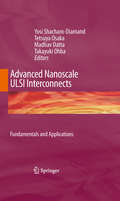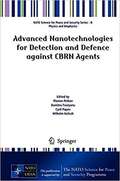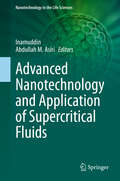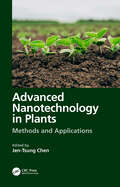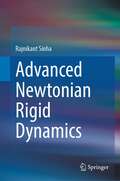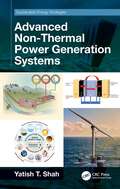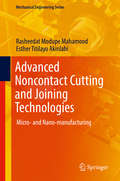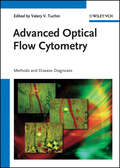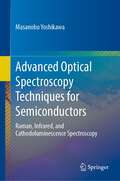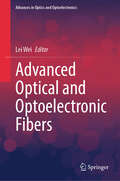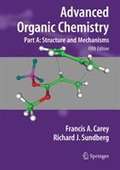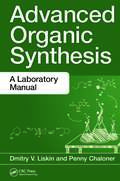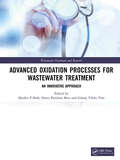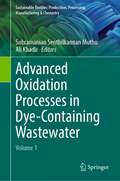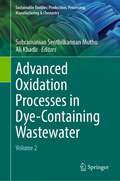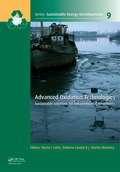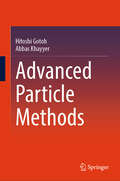- Table View
- List View
Advanced Nanomaterials and Nanotechnology: Proceedings of the 2nd International Conference on Advanced Nanomaterials and Nanotechnology, Dec 8-10, 2011, Guwahati, India (Springer Proceedings in Physics #143)
by A. Perumal D. K. Goswami P. K. GiriNanoscale science and technology have occupied centre stage globally in modern scientific research and discourses in the early twenty first century. The enabling nature of the technology makes it important in modern electronics, computing, materials, healthcare, energy and the environment. This volume contains selected articles presented (as Invited/Oral/Poster presentations) at the 2nd international conference on advanced materials and nanotechnology (ICANN-2011) held recently at the Indian Institute of Technology Guwahati, during Dec 8-10, 2011. The list of topics covered in this proceedings include: Synthesis and self assembly of nanomaterials Nanoscale characterisation Nanophotonics & Nanoelectronics Nanobiotechnology Nanocomposites F Nanomagnetism Nanomaterials for Energy Computational Nanotechnology Commercialization of Nanotechnology The conference was represented by around 400 participants from several countries including delegates invited from USA, Germany, Japan, UK, Taiwan, Italy, Singapore, India etc.
Advanced Nanomaterials for Detection of CBRN (NATO Science for Peace and Security Series A: Chemistry and Biology)
by Janez Bonča Sergei KruchininThis book is devoted to advanced materials and perspective sensors, which is one of the most important problems in nanotechnology and security. This book is useful for researchers, scientist and graduate students in the fields of solid state physics, nanotechnology and security.
Advanced Nanomaterials for Energy Storage Devices (Nanostructure Science and Technology)
by H. P. Nagaswarupa H. C. Ananda Murthy Ramachandra Naik Mika E. T. SillanpääThis contributed volume provides a comprehensive overview of nanomaterials tailored for energy storage applications, covering fundamental concepts such as computational design and modeling, synthesis techniques, characterization methods, and advanced strategies for enhancing energy storage performance. Through case studies, it demonstrates the practical applications of nanomaterials in specific energy storage devices, highlighting their significance. The book also explores advanced electrode types and fabrication techniques, addresses challenges and opportunities in the field, and offers insights into future perspectives and emerging trends. It serves as an essential resource for researchers, scientists, engineers, and students interested in materials science, nanotechnology, and energy storage, providing a thorough understanding of the latest advancements and potential developments in the field.
Advanced Nanomaterials for Wastewater Remediation (Advances in Water and Wastewater Transport and Treatment)
by Ravindra Kumar Gautam and Mahesh Chandra ChattopadhyayaContamination of aqueous environments by hazardous chemical compounds is the direct cause of the decline of safe clean water supply throughout the globe. The use of unconventional water sources such as treated wastewater will be a new norm. Emerging nanotechnological innovations have great potential for wastewater remediation processes. Applications that use smart nanomaterials of inorganic and organic origin improve treatment efficiency and lower energy requirements. This book describes the synthesis, fabrication, and application of advanced nanomaterials in water treatment processes; their adsorption, transformation into low toxic forms, or degradation phenomena, and the adsorption and separation of hazardous dyes, organic pollutants, heavy metals and metalloids from aqueous solutions. It explains the use of different categories of nanomaterials for various pollutants and enhances understanding of nanotechnology-based water remediation to make it less toxic and reusable.
Advanced Nanomaterials in Biomedical, Sensor and Energy Applications
by Rohit Srivastava Jayeeta ChattopadhyayThis book is aimed at all those who are interested to understand the current research going on in nanomaterial science from the perspectives of biomedical, sensorial and energy applications including all aspects of physical chemist, chemical engineers and material scientist. Nanoscience and nanotechnology are at the forefront of modern research. The fast growing economy in this area requires experts with outstanding knowledge of nanoscience in combination with the skills to apply this knowledge in new products. A multidisciplinary scientific education is crucial to provide industry and research institutes with top quality experts who have a generic background in the different sub disciplines such as electronics, physics, chemistry, material science, biotechnology. The book covers recent advancement in nanoscience and nanotechnology particularly highlights the utilization of different types of nanomaterials in biomedical field, sensor and in the energy application. On the other hand, it leads the reader to the most significant recent developments in research. It provides a broad and in-depth coverage of the nanoscale materials and its depth significant applications.
Advanced Nanoscale ULSI Interconnects: Fundamentals And Applications
by Madhav Datta Yosi Shacham-Diamand Takayuki Ohba Tetsuya OsakaThis book presents one of the new frontiers of modern electrochemistry science and technology: electrochemical processes for Ultra-large-Scale Integration (ULSI) technology for Integrated Circuits (ICs) applications. This is a field which influences our day to day life and still presents major technological and scientific challenges. This book reviews ULSI technology in light of all the novel electrochemical processes which make ULSI technology possible. The book will focus on sub-100 nm CMOS technology, mainly on copper-based metallization.
Advanced Nanotechnologies for Detection and Defence against CBRN Agents (NATO Science For Peace And Security Series B: Physics and Biophysics)
by Wilhelm Kulisch Cyril Popov Plamen Petkov Dumitru TsiulyanuProvides an up-to-date overview on various nanostructured materials and nanotechnologies for different security and safety related areas. <P><P>The content spans synthesis, characterization and diverse applications of nanoscaled materials.<P> Includes contributions from physicists, chemists, material scientists, engineers and biologists.<P>This volume gives a broad overview of advanced technologies for detection and defence against chemical, biological, radiological and nuclear (CBRN) agents. It provides chapters addressing the preparation and characterization of different nanoscale materials (metals, oxides, glasses, polymers, carbon-based, etc.) and their applications in fields related to security and safety. In addition, it presents an interdisciplinary approach as the contributors come from different areas of research, such as physics, chemistry, engineering, materials science and biology. A major feature of the book is the combination of longer chapters introducing the basic knowledge on a certain topic, and shorter contributions highlighting specific applications in different security areas.
Advanced Nanotechnology and Application of Supercritical Fluids (Nanotechnology in the Life Sciences)
by Inamuddin Abdullah M. AsiriGlobalization and industrialization involve a number of reactions, products, extractions, and separations that require the use of organic solvents. These solvents are responsible for a number of ecological concerns, including atmospheric and land toxicity. Conventional organic solvents are regarded as volatile organic compounds; some are even limited due to their potential for ozone layer depletion. While supercritical liquids exhibit physical properties that could make them ideal substitutes for these volatile compounds, there is particular interest in the use of carbon dioxide as a solvent of crude material. In particular, carbon dioxide has apparent ‘green’ properties, like its noncombustible nature, the fact that it is generally nonpoisonous, and its relative inertness. Thus, the use of supercritical carbon dioxide can provide practical improvements to the sustainability of industrial products and processes. This book provides in-depth literature in the area of industrial green processes, focusing on the separation, purification, and extraction of compounds utilizing supercritical carbon dioxide as a green solvent.
Advanced Nanotechnology in Plants: Methods and Applications
by Jen-Tsung ChenNanotechnology uses nanomaterials/nanoparticles that can penetrate plant cells and interact with intracellular organelles and metabolites impacting plant growth, development, physiology, and biochemistry. Advanced Nanotechnology in Plants: Methods and Applications explores emerging plant nanotechnology, covering advanced methods and applications with an emphasis on the mitigation of plant diseases and environmental stressors. This technology can lead to the improvement of crop quality and yield to face the challenge of global climate change with an expanding global population.Features: Summarizes advanced methods and current applications of nanotechnology to mitigate plant stress Supports the Paris Agreement, which tackles three main objectives for sustainably increasing agricultural productivity and incomes, adapting and building resilience to climate change, and reducing and/or removing greenhouse gas emissions Discusses potential uses and future directions in green nanotechnology for smart and sustainable agriculture The content fits the goals of the UN SDGs contributing to goals 12 and 15 for responsible consumption and production and sustainable use of terrestrial ecosystems Provides current research findings of engineered nanoparticles for phytoremediation This book is a reference for students, researchers, and scientists in the field of plant sciences and nanotechnology. It is also useful for those in green chemistry, and environmental sciences, and can be a practical handbook for academics, including teachers, students, and agricultural experts.
Advanced Nanovaccines for Cancer Immunotherapy: Harnessing Nanotechnology for Anti-Cancer Immunity
by Nanasaheb ThoratThis book provides an in-depth look into the application of cancer vaccines in the treatment of cancer, which is being enhanced by advances in nanotechnology. Delving into nanovaccine science and showcasing its potential in the fight against cancer, immunotherapy explores the possibilities of using nano-sized drugs to boost the body's immune system and combat cancerous cells. Cancer vaccines are becoming increasingly diverse – this book reveals their different types and how they are being developed. Chapter by chapter, it offers invaluable knowledge in this burgeoning field. Readers will learn about the potential of nanomedicine for improved vaccine delivery, overcoming drug resistance, and clinical applications. With its problem-based approach and state-of-the-art technologies, this book is an excellent and informative resource for researchers, clinicians, and students seeking to apply nanotechnology in the fight against this deadly disease.
Advanced Newtonian Rigid Dynamics
by Rajnikant SinhaThis book discusses topics on D’Alembert’s principle, virtual work, Eulerian angles, Lagrange’s equation in generalized coordinates and motion of a top. Momental ellipsoid of a point of a rigid body and conservation principle of angular momentum are discussed in detail. This is an essential textbook on Newtonian rigid dynamics, useful for advanced undergraduate and graduate students of physics, mathematics and engineering. This book contains solutions to more than 350 examples as well as more than 350 figures, which are nicely explaining the concept of rigid dynamics. Necessary mathematics have been created at the spot where they are needed.
Advanced Non-Thermal Power Generation Systems (Sustainable Energy Strategies)
by Yatish T. ShahGenerally, sources for power generation are broken down into two categories: thermal and non-thermal. Thermal sources for power generation include combustion, geothermal, solar, nuclear, and waste heat, which essentially provide heat as a means for power generation. This book examines non-thermal (mechanical, electrochemical, nanoscale self-powered, and hybrid) sources of power generation and emphasizes recent advances in distributed power generation systems. Key Features Details recent advances made in wind power, including onshore, offshore, fixed and floating platform, and air wind energy systems, and offers detailed assessments of progress Covers advances in generation of hydropower, exploring dam hydropower, novel wave energy converters, and novel systems and turbines for hydrokinetic energy conversion to power Examines all types of fuel cells and their multi-functional roles, along with hybrid fuel cell systems in complete detail Explores advances in the development of self-powered nanogenerators for use in portable, wearable, and implantable power electronics Focuses on technologies with the best commercial possibilities and provides perspectives on future challenges that need to be solved This book will be of value to all researchers in academia, industry, and government interested in pursuing power generation technologies and seeking a comprehensive understanding of available and emerging non-thermal power generation sources. Readers who are interested in learning about thermal power generation sources can find it in the author’s companion text Advanced Power Generation Systems: Thermal Sources (2023).
Advanced Noncontact Cutting and Joining Technologies: Micro- And Nano-manufacturing (Mechanical Engineering)
by Rasheedat Modupe Mahamood Esther Titilayo AkinlabiThis book illuminates advanced cutting and joining processes, what they are used for, and the capabilities of these manufacturing techniques, especially in micro- and nano-fabrication. The authors illustrate the use of water jets and lasers that can be used to cut highly complex shapes without leaving burrs of heat affected zones, as well as friction stir welding processes that were not possible in the past. Rounding out their examination, the authors describe in detail the use of additive manufacturing for fabrication of micro and nano-scale components and the direction of future research. Incorporating many examples from industry, the book is ideal for professional engineers, technicians, and fabrication managers in multiple industries.
Advanced Nondestructive Detection Technologies in Food
by Jiewen Zhao Quansheng Chen Hao LinThis book comprehensively introduces non-destructive methods for food quality (i.e. external, internal, sensory, components, and microbiological indicators) detection, through optics, acoustics, chemistry, imaging, and bionic sensing. It highlights in-situ detection of food quality and safety, including principles, signal processing, and analysis of data, non-destructive detection system, and application in the food industry for each method. First, this book introduces the principles and characteristics of various food non-destructive methods. As non-destructive measurements always involve obtaining big data for each testing, this book also describes in detail the signal and big data processing for each non-destructive method. The chapters also introduce the rapid portable detection equipment for food and agricultural products developed in recent years, as well as the intelligent monitoring equipment in the process of food processing. Relevant application cases are provided to help readers better understanding how to apply non-destructive technology for food quality detection. In the noninvasive measurement of food quality, this book has a systematic introduction of the detection principle, data processing, and rapid detection system, in-field detection case studies. This book is novel and practical and can be used as a professional textbook for undergraduates majoring in food science and engineering. It can also be used as a reference book for scientific research and technical personnel engaged in the field of food quality and safety detection.
Advanced Optical Flow Cytometry: Methods and Disease Diagnoses
by Valery V. TuchinA detailed look at the latest research in non-invasive in vivo cytometry and its applications, with particular emphasis on novel biophotonic methods, disease diagnosis, and monitoring of disease treatment at single cell level in stationary and flow conditions. This book thus covers the spectrum ranging from fundamental interactions between light, cells, vascular tissue, and cell labeling particles, to strategies and opportunities for preclinical and clinical research. General topics include light scattering by cells, fast video microscopy, polarization, laser-scanning, fluorescence, Raman, multi-photon, photothermal, and photoacoustic methods for cellular diagnostics and monitoring of disease treatment in living organisms. Also presented are discussions of advanced methods and techniques of classical flow cytometry.
Advanced Optical Spectroscopy Techniques for Semiconductors: Raman, Infrared, and Cathodoluminescence Spectroscopy
by Masanobu YoshikawaThis book focuses on advanced optical spectroscopy techniques for the characterization of cutting-edge semiconductor materials. It covers a wide range of techniques such as Raman, infrared, photoluminescence, and cathodoluminescence (CL) spectroscopy, including an introduction to their physical fundamentals and best operating principles. Aimed at professionals working in the research and development of semiconductors and semiconductor materials, this book looks at a broad class of materials such as silicon and silicon dioxide, nano-diamond thin films, quantum dots, and gallium oxide. In addition to the spectroscopic techniques covered, this book features a chapter devoted to the use of a scanning electron transmission microscope as an excitation source for CL spectroscopy. Written by a practicing industry expert in the field, this book is an ideal source of reference and best-practices guide for physicists, as well as materials scientists and engineers involved in the area of spectroscopy of semiconductor materials. Further, this book introduces the cutting-edge spectroscopy such as optical photothermal IR and Raman spectroscopy or terahertz time-domain spectroscopy (THz-TDS) etc.
Advanced Optical and Optoelectronic Fibers (Advances in Optics and Optoelectronics)
by Lei WeiThis book highlights the recent scientific and technological innovations of various optical and optoelectronic fibers based on different functional structures and materials. Advanced optical and optoelectronic fibers locate at the intersection of many disciplines ranging from optical waveguides, optoelectronics, material engineering, micro/nanofabrication, and neural interfaces to wearable devices. The book covers the major developments on fiber materials, such as semiconductors, metals, polymers, and soft glasses, as well as novel in-fiber structures. Different functionalities are also summarized, including sensing, light guidance, lasing, and material engineering toward full system integration. The book is a valuable resource for researchers, engineers, and graduate students engaged in the study of optical and optoelectronic fibers.
Advanced Organic Chemistry
by David E. LewisWritten by a master teacher, Advanced Organic Chemistry presents a clear, concise, and complete overview of the subject that is ideal for both advanced undergraduate and graduate courses. In contrast with many other books, this volume is a true textbook, not a reference book.
Advanced Organic Chemistry
by Francis A. Carey Richard J. SundbergSince its original appearance in 1977, Advanced Organic Chemistry has maintained its place as the premier textbook in the field, offering broad coverage of the structure, reactivity and synthesis of organic compounds. As in the earlier editions, the text contains extensive references to both the primary and review literature and provides examples of data and reactions that illustrate and document the generalizations. While the text assumes completion of an introductory course in organic chemistry, it reviews the fundamental concepts for each topic that is discussed. <p><p> The two-part fifth edition has been substantially revised and reorganized for greater clarity. Among the changes: Updated material reflecting advances in the field since 2001’s Fourth Edition, especially in computational chemistry; A companion Web site provides digital models for study of structure, reaction and selectivity; Solutions to the exercises provided to instructors online. <p> The material in Part A is organized on the basis of fundamental structural topics such as structure, stereochemistry, conformation and aromaticity and basic mechanistic types, including nucleophilic substitution, addition reactions, carbonyl chemistry, aromatic substitution and free radical reactions. Together with Part B: Reaction and Synthesis, the two volumes are intended to provide the advanced undergraduate or beginning graduate student in chemistry with a sufficient foundation to comprehend and use the research literature in organic chemistry.
Advanced Organic Synthesis: A Laboratory Manual
by Penny Chaloner Dmitry V. LiskinLaboratory experience equips students with techniques that are necessary for professional practice. Advanced Organic Synthesis: A Laboratory Manual focuses on a mechanistic background of key reactions in organic chemistry, gives insight into well-established trends, and introduces new developments in the field.The book features experiments performe
Advanced Oxidation Processes for Wastewater Treatment: An Innovative Approach (Wastewater Treatment and Research)
by Maulin P. Shah Sweta Parimita Bera Günay Yıldız TöreAdvanced Oxidation Processes for Wastewater Treatment: An Innovative Approach: This book highlights the importance of various innovative advanced oxidation technology to clean up the environment from pollution caused by human activities. It assesses the potential application of several existing bioremediation techniques and introduces new emerging technologies. This book is an updated vision of the existing advanced oxidation strategies with their limitations and challenges and their potential application to remove environmental pollutants. It also introduces the new trends and advances in environmental bioremediation technology with thorough discussion of recent developments in this field. This book highlights the importance of different innovative advanced oxidation process to deal with the ever-increasing number of environmental pollutants. Features: Illustrates the importance of various advance oxidation processes in effluent treatment plant Points out the reuse of the treated wastewater through emerging advance oxidation technologies for effluent treatment plant Highlights the recovery of resources from wastewater Pays attention to the occurrence of novel micro-pollutants Emphasizes the role of nanotechnology in bioremediation of pollutants Introduces new trends in environmental bioremediation
Advanced Oxidation Processes in Dye-Containing Wastewater: Volume 1 (Sustainable Textiles: Production, Processing, Manufacturing & Chemistry)
by Subramanian Senthilkannan Muthu Ali KhadirAmong various industries releasing wastewater into the environment, printing, dyeing and textile industries are of great importance as they frequently contain high amounts of colorful compounds having high chemical and biological oxygen demands. Health related effects of colorants are extensively reported; which necessitates the seriousness of dye removal from water and wastewater. The utilization of advanced oxidation processes (AOPs) in dye degradation has gained considerable attention recently due to the release of high energetic radicals as oxidants that are capable of removing dye compounds. This Volume 1 presents versatile applications of AOPs in dye removal. Accordingly, processes such as Ozone-based AOPs, UV irradiation, catalytic AOPs, etc are discussed with the aim of dye removal under different operational parameters. The role of different nanoparticles is also investigated. By presenting the fundamentals of AOPs as well as recent advances, this book is useful for environmental engineers and chemists who are concerned with wastewater pollution and treatment.
Advanced Oxidation Processes in Dye-Containing Wastewater: Volume 2 (Sustainable Textiles: Production, Processing, Manufacturing & Chemistry)
by Subramanian Senthilkannan Muthu Ali KhadirTextile industry wastewater contains toxic dyes as well as heavy metals and many other persistent organic compounds which are difficult to biodegrade using conventional biological methods. Advanced Oxidation Processes (AOPs) are one of the best alternatives for the effective degradation of such compounds. This Volume 2 starts with homogeneous and heterogeneous Fenton processes and reviews the application and variables that affect the process. It then discusses plasma technology- an emerging method in terms of its chemistry, treatment set-up, limitations, etc. The positive performance of carbon tetrachloride in process intensification of dye degradation is presented. The other chapters include topics such as sonoenzymatic treatment processes, electroflocculation versus textile wastewater, combination of photocatalysis and membrane Separation, and enhancement of anaerobic digestion and photodegradation through adsorption.
Advanced Oxidation Technologies: Sustainable Solutions for Environmental Treatments (Sustainable Energy Developments)
by Marta I. Litter Roberto J. Candal J. Martín MeichtryAdvanced Oxidation Technologies (AOTs) or Processes (AOPs) are relatively new and innovative technologies to remove harmful and toxic pollutants. The most important processes among them are those using light, such as UVC/H2O2, photo-Fenton and heterogeneous photocatalysis with TiO2. These technologies are also relatively low-cost and therefore usef
Advanced Particle Methods
by Hitoshi Gotoh Abbas KhayyerThis book provides an in-depth, comprehensive, and comprehensible description of the theoretical background and numerical methodologies corresponding to advanced particle methods formulated in classical Newtonian mechanics for simulation of fluids, structures, and their interactions. Particle methods are regarded as new-generation computational technology with a broad range of applications in engineering and science. Advanced particle methods refer to the latest developed particle methods with high stability, accuracy, conservation, and convergence properties. Distinctively, the described advanced particle methods are characterized by a clear, consistent mathematical–physical background, the absence of artificial numerical stabilizers that often require parameter tuning, rigorous satisfaction of boundary conditions, and excellent numerical results that have been extensively and scrupulously verified with respect to reliable analytical and experimental reference solutions. This book presents a unified description for both smoothed particle hydrodynamics (SPH) and moving particle semi-implicit (MPS) methods through a coherent presentation of fundamental equations, and numerical algorithms and schemes. Special attention is devoted to meticulous and coherent explanation of the advanced particle methods such that even undergraduate students can follow the derivation process and thoroughly understand the concepts and equations. The state-of-the-art particle method technology is also portrayed with the presentation of developed multi-physics, multi-scale particle methods corresponding to multi-phase flows, and hydroelastic fluid–structure interactions with rigorous treatment of interfacial moving boundaries.
